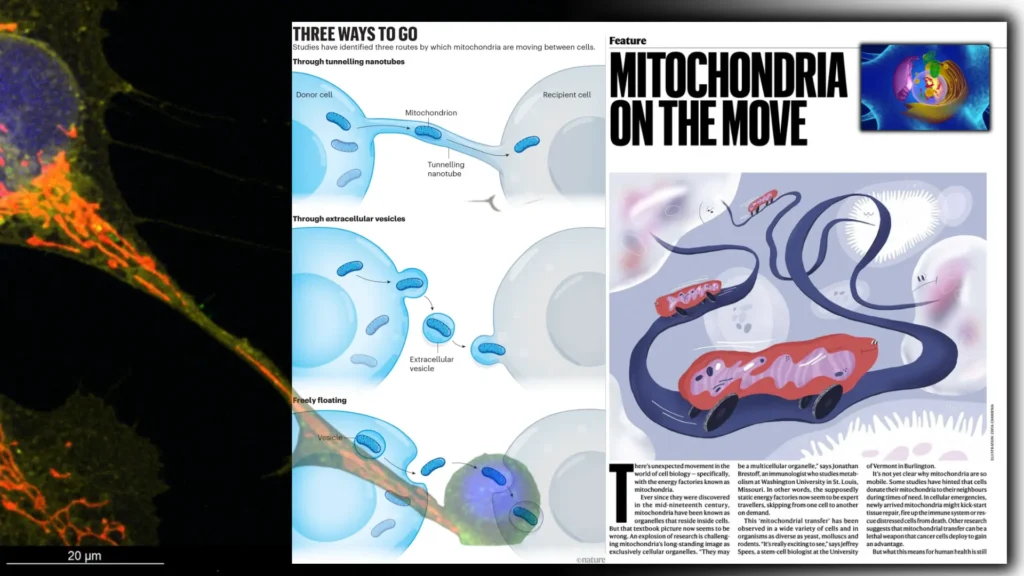Researchers are studying why these energy factories move between cells and whether the process can be harnessed to treat cancer and other diseases.
For over a century, mitochondria have been known as the static powerhouses of the cell—tiny organelles nestled inside, converting nutrients into energy. But a growing body of research is turning this long-held belief on its head. Scientists are discovering that mitochondria are far more mobile than previously thought, capable of traveling between cells in a phenomenon called mitochondrial transfer.

This unexpected behavior has been observed in organisms ranging from yeast to rodents, raising tantalizing questions about its role in health and disease. Could this process help repair damaged tissues, boost immunity, or even aid in fighting cancer? Or could it be hijacked by diseases to spread harm?
A Shifting Paradigm in Cell Biology
Mitochondria are ancient structures—descendants of bacteria that were engulfed by early eukaryotic cells around 1.5 billion years ago. Their microbial origins might explain why they retain the ability to move between cells, says Kazuhide Hayakawa, a neuroscientist at Massachusetts General Hospital. “It’s possible that mitochondria still behave like their bacterial ancestors, spreading from cell to cell,” he explains.
The first direct evidence of mitochondrial transfer came in 2006, when Jeffrey Spees, a stem-cell biologist at the University of Vermont, and his team filmed fluorescently tagged mitochondria moving from healthy stem cells to damaged lung cells in a lab dish. The lung cells, previously struggling to produce energy, suddenly revived. “Watching it was like a miracle,” Spees recalls.
Since then, researchers have documented mitochondria traveling between various cell types—neurons, heart cells, immune cells—via tiny tunnels called tunneling nanotubes, bubble-like vesicles, or even floating freely in blood.

A Lifeline in Times of Crisis?
Mounting evidence suggests that mitochondrial transfer acts as a form of cellular rescue mission.
- Stroke Recovery: In 2016, Hayakawa’s team found that after a stroke in mice, support cells called astrocytes donated mitochondria to struggling neurons, helping them survive and regrow connections. Blocking this transfer led to more neuronal death.
- Lung Injury: Jahar Bhattacharya at Columbia University observed that in mice with acute lung inflammation, connective tissue cells transferred mitochondria to lung cells, restoring energy production and aiding recovery.
- Wound Healing: In 2021, Anne-Marie Rodriguez at Sorbonne University found that platelets donated mitochondria to stem cells, which then accelerated skin wound healing in mice.
“Cells might actually request healthy mitochondria when theirs fail,” says Clair Crewe, a cell biologist at Washington University. But how this signaling works remains unclear.
A Double-Edged Sword?
While mitochondrial transfer often appears beneficial, it may also have a dark side. Some studies suggest that cancer cells exploit the process to steal mitochondria from healthy cells, boosting their own survival.
Additionally, disruptions in mitochondrial transfer might contribute to chronic diseases. Patricia Alejandra Luz-Crawford, an immunologist at the University of the Andes, found that stem cells from people with rheumatoid arthritis transferred fewer mitochondria to T cells, possibly worsening inflammation.
Therapeutic Potential—and Unanswered Questions
Researchers are already exploring ways to harness mitochondrial transfer for therapy. Could delivering healthy mitochondria help treat stroke, heart disease, or metabolic disorders? Early experiments in mice are promising, but major hurdles remain.
“We still don’t know how long donated mitochondria last inside recipient cells or exactly how they integrate,” says Luz-Crawford. Daniel Davis, an immunologist at Imperial College London, adds that no one has yet directly observed mitochondrial transfer in living humans.
Despite the unknowns, one thing is clear: mitochondria are not just cellular power plants—they’re dynamic players in health and disease. As research continues, scientists hope to unlock new ways to manipulate this process, potentially revolutionizing medicine.

Image Source: Nature – Credit: Jeremy Baldwin
References
- Cells are swapping their mitochondria. What does this mean for our health? – Nature – (Accessed on Apr 13, 2025)
- Ryu, K. W. et al. Nature 635, 746–754 (2024). – PubMed – DOI
- Mosharov, E. V. et al. Nature https://doi.org/10.1038/s41586-025-08740-6 (2025). – DOI
- Spees, J. L., Olson, S. D., Whitney, M. J. & Prockop, D. J. Proc. Natl Acad. Sci. USA 103, 1283–1288 (2006). – PubMed – DOI
- Borcherding, N. & Brestoff, J. R. Nature 623, 283–291 (2023). – PubMed – DO
Possible References Used







